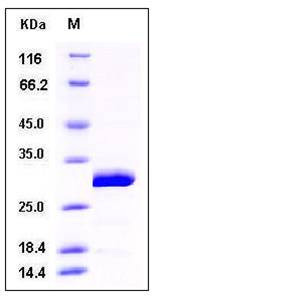Mouse UCHL3 / UCH-L3 Protein (His Tag)
UCHL3
- 100ug (NPP2804) Please inquiry
| Catalog Number | P50692-M07E |
|---|---|
| Organism Species | Mouse |
| Host | E. coli |
| Synonyms | UCHL3 |
| Molecular Weight | The recombinant mouse UCHL3 consisting of 240 amino acids and has a calculated molecular mass of 27.5 kDa. rm UCHL1 migrates as an approximately 30 kDa band in SDS-PAGE under reducing conditions. |
| predicted N | Met |
| SDS-PAGE |  |
| Purity | > 97 % as determined by SDS-PAGE |
| Protein Construction | A DNA sequence encoding the mouse UCHL3 (Q9JKB1) (Glu 2-Ala 230) was expressed, with a polyhistide tag at the N-terminus. |
| Bio-activity | Measured by the hydrolysis of UbiquitinAMC . The specific activity is >14000 pmoles/min/μg. |
| Research Area | Immunology |Signal Transduction |Akt Pathway |Ubiquitin-related Molecules in the Akt Pathway |
| Formulation | Lyophilized from sterile 50mM Tris, 150mM NaCl, 20% glycerol, pH 7.7 1. Normally 5 % - 8 % trehalose and mannitol are added as protectants before lyophilization. Specific concentrations are included in the hardcopy of COA. |
| Background | Ubiquitin carboxyl-terminal hydrolase isozyme L3, also known as UCH-L3, Ubiquitin thioesterase L3 and UCHL3, is a ubiquitin-protein hydrolase which belongs to the peptidase C12 family. It is involved both in the processing of ubiquitin precursors and of ubiquitinated proteins. This enzyme is a thiol protease that recognizes and hydrolyzes a peptide bond at the C-terminal glycine of either ubiquitin or NEDD8. UCHL3 is highly expressed in heart, skeletal muscle, and testis. UCHL1 and UCHL3 are two of the deubiquitinating enzymes expressed in the brain. These phenotypes indicate the importance of UCHL1 and UCHL3 in the regulation of the central nervous system. UCHL3 functions as a de-ubiquitinating enzyme where lack of its hydrolase activity may result in the prominent accumulation of ubiquitinated proteins and subsequent induction of stress responses in skeletal muscle. UCHL3 has also been identified as a tumor-specific antigen in colon cancer. |
| Reference |
